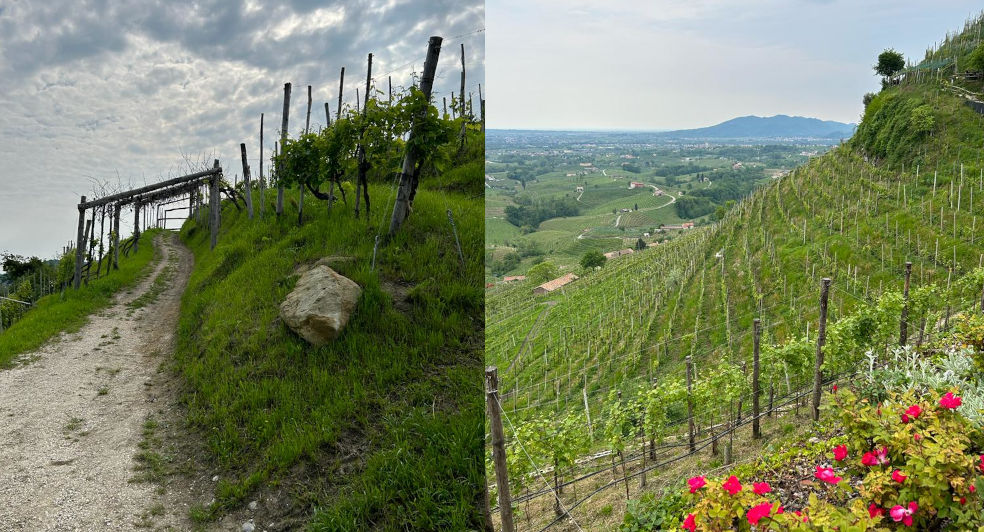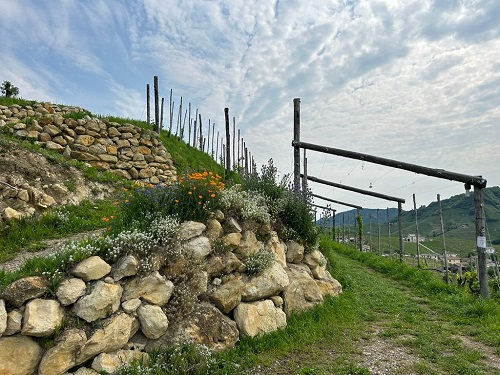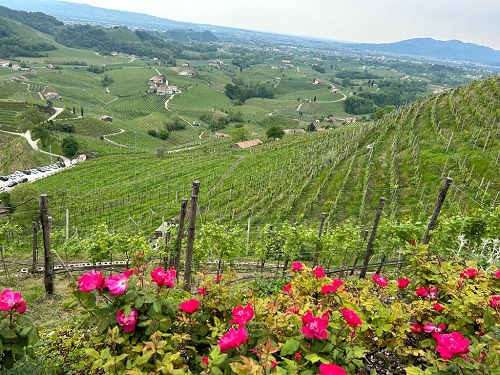Conegliano Valdobbiadene: The Heart of Prosecco
22nd June 2023

Inside the big area of production of Prosecco (9 provinces in Veneto and Friuli Venezia Giulia) there is the small area of “Conegliano Valdobbiadene” that represents the heart of the world of Prosecco.
Conegliano Valdobbiadene is the most vocated area to produce Prosecco.
Recognised since 1969 as one of the historical Italian Denomination, in 2009, thanks to the re-organization of the Prosecco system, Conegliano Valdobbiadene was classified as DOCG (Denominazione di Origine Controllata e Garantita), the top-quality level of the Italian wines.
Conegliano Valdobbiadene DOCG is in Veneto, in the Province of Treviso and consists of 15 communes (municipal areas); it’s a hilly zone in which the winegrowing has extremely ancient origins. The vignerons transmitted from generation to generation, their savoir faire and their secrets creating a culture that now is part of the whole local people.
Conegliano and Valdobbiadene are two of the 15 communes of the area and give the name to the Denomination: Conegliano, on the east side, is the cultural capital while Valdobbiadene, in the west side, is the heart of the production.
The morphology that characterizes the landscape of Conegliano Valdobbiadene is the result of a combination between the movements of the Earth’s crust and the geological structures present locally. The movement of the African plate pushed a series of layers of rocks against the massif of the Prealps that rose up like a wave.
Over the time the erosion and action of the glaciers of the Dolomites produced a succession of parallel hills.
The soils of the area have very ancient origins and keep differences: fine-textured soils often containing carbonates are alternate with soils of marine origin with marls and sandstone.

The position between the sea and the Alps ensures a mild climate; the constant ventilation together with the altitude (from 50 to 500 meters) grant a marked difference between day and night-time temperatures.
The various combination of soils, slope and exposure make each micro-zone different, and those characteristics will be transferred to the wine creating a numerous variety of expressions.
Even if Conegliano Valdobbiadene can be produced as “Frizzante” (semi-sparkling) or “Tranquillo” (still), the iconic type is the sparkling wine and the word “Superiore” il added to “Prosecco”. So, the Prosecco Superiore, depending on its residual sugar content, may be:
– Extra Brut, the most contemporary version, in line with the international trends; highlights the bright fruitiness of the grapes and it’s a great expression of the terroirs. (residual sugar from 0 to 6 g/l)
– Brut, rich in citrusy aromas and vegetal notes, this style is in harmony with modern and international tastes. (residual sugar from 0 to 12 g/l)
– Extra-Dry, the most traditional style that combine the typical varietal aromas with tanginess enhanced by bubbles. The wine is rounded but results yet quite dry thanks to its lovely acidity (residual sugar from 12 to 17 g/l)
– Dry, the oldest style, today least common. Mellow on the palate thanks to the sweetness note, should be served very cool in order to moderate its sweetness. (residual sugar from 17 to 32 g/l).
There are two versions of Prosecco Superiore that represent the higher level of the Denomination, a kind of “cru”.

– Rive (that in the local dialect means the very steep hillsides, characteristics of Conegliano Valdobbiadene area); 43 locations have been identified and classified. A Prosecco Superiore can mention in the label the name of the “Rive” when all the grapes come from one of those areas and has been picked by hand. Each “Rive” transmits to the wine different characteristics due to distinctive soil, exposure and microclimate.
– Cartizze, the qualitative peak of the Denomination. Only 107 hectares of steepest hills shaped like a pentagon in the commune of Valdobbiadene. The nature of the soils (moraines, sandstone and clays) together with the particular microclimate give the wine unique characteristics: very complex aromas which recall white fleshed fruits such as apples and pears, citrus fruits and peach. The flavour is elegant with great mellowness and freshness. The most classic version is “Dry” nevertheless recently some vigneron started the production in the “extra-dry” or “brut” styles.
Images Belong To Paolo Valente, Glass of Bubbly Was Granted Permission To Use Them.
![]()
Paolo Valente
Journalist and wine enthusiast, He loves to tell stories of people and places and is convinced that wine is above all the result of man's passion, work and intelligence.
